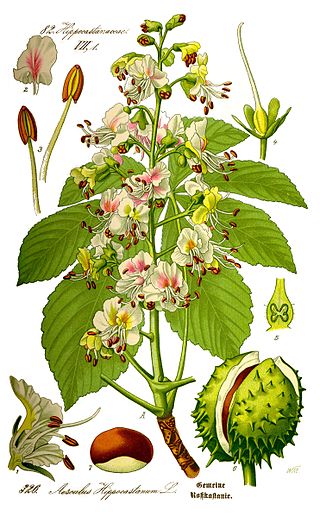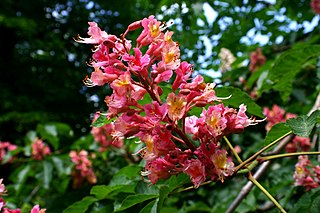See also
- Horse-chestnut leaf miner, a moth of the lepidopteran family Gracillariidae
- Chestnut (disambiguation)
Horse chestnut may refer to:
Buckeye may refer to:

Aesculus pavia, known as red buckeye or firecracker plant, is a species of deciduous flowering plant. The small tree or shrub is native to the southern and eastern parts of the United States, found from Illinois to Virginia in the north and from Texas to Florida in the south. It is hardy far to the north of its native range, with successful cultivation poleward to Arboretum Mustila in Finland.

The genus Aesculus, with species called buckeye and horse chestnut, comprises 13–19 species of flowering plants in the family Sapindaceae. They are trees and shrubs native to the temperate Northern Hemisphere, with six species native to North America and seven to 13 species native to Eurasia. Several hybrids occur. Aesculus exhibits a classical Arcto-Tertiary distribution.

Ungnadia is a genus of flowering plants in the family Sapindaceae containing one species, Ungnadia speciosa, the Mexican buckeye. It is native to northern Mexico, as well as Texas and southern New Mexico in the United States. The name honours Austrian ambassador Baron David von Ungnad, who brought the horse chestnut to Vienna in 1576, introducing the plant into western Europe.

Aesculus hippocastanum, the horse chestnut, is a species of flowering plant in the maple, soapberry and lychee family Sapindaceae. It is a large, deciduous, synoecious (hermaphroditic-flowered) tree. It is also called horse-chestnut, European horsechestnut, buckeye, and conker tree. It is not to be confused with the Spanish chestnut, Castanea sativa, which is a tree in another family, Fagaceae.

Aesculus glabra, commonly known as Ohio buckeye, Texas buckeye, fetid buckeye, and horse chestnut is a species of tree in the soapberry family (Sapindaceae) native to North America.

Aesculus flava, also known commonly as the common buckeye, the sweet buckeye, and the yellow buckeye, is a species of deciduous tree in the subfamily Hippocastanoideae of the family Sapindaceae. The species is native to the Ohio Valley and Appalachian Mountains of the Eastern United States. It grows in mesophytic forest or floodplains, generally in acid to circumneutral soil, reaching a height of 20m to 48m.

Aesculus californica, commonly known as the California buckeye or California horse-chestnut, is a species of buckeye native to California and southwestern Oregon.
Chestnut is a genus of deciduous trees and shrubs, and the name of the edible nut they produce.

Aesculin, also called æsculin or esculin, is a coumarin glucoside that naturally occurs in the trees horse chestnut, California buckeye, prickly box, and daphnin. It is also found in dandelion coffee and olive bark. It is reported to present in olive bark, not in olive leaf, therefore, identification of aesculin in abundant in an extract indicates the extract derived from olive bark.

Aesculus parviflora, the bottlebrush buckeye or small-flowered buckeye, is a species of suckering deciduous shrub in the family Sapindaceae. The species is native to the southeastern United States, where it is found primarily in Alabama and Georgia, with a disjunct population in South Carolina along the Savannah River. Its natural habitat is in mesic forests, on bluffs and in ravines.
Fish toxins or fish stupefying plants have historically been used by many hunter gatherer cultures to stun fish, so they become easy to collect by hand. Some of these toxins paralyse fish, which can then be easily collected. The process of documenting many fish toxins and their use is ongoing, with interest in potential uses from medicine, agriculture, and industry.

Aesculus × carnea, or red horse-chestnut, is a medium-sized tree, an artificial hybrid between A. pavia and A. hippocastanum (horse-chestnut). Its origin uncertain, probably appearing in Germany before 1820. It is a popular tree in large gardens and parks.
Handeliodendron bodinieri is a rare deciduous tree/shrub native to China and the only species in the monotypic genus Handeliodendron.
A. californica may refer to:
A. chinensis may refer to:

Aesculus indica, commonly known as the Indian horse-chestnut or Himalayan horse chestnut, is a species of deciduous broad-leaved tree in the family Sapindaceae.

Aesculus chinensis, the Chinese horse chestnut or Chinese buckeye, is a deciduous temperate tree species in the genus Aesculus found across China. It was first successfully introduced to Britain in 1912 by plant collector William Purdom, who collected six young plants from the grounds of a temple in the western hills of Beijing, and brought them back to Veitch's Nursery in Coombe Hill near London. Purdom's correspondence regarding this event are held in the archives of the Arnold Arboretum. One plant was sent to the Royal Botanic Gardens Kew and two to the Arnold Arboretum in Boston. The original tree at Kew no longer exists but a young tree grafted from the original now grows in the Rhododendron Dell.
A. flava may refer to:

Aesculus parryi, known as the Parry buckeye or Baja California buckeye, is a species of shrub or small tree in the genus Aesculus. It is native to Mexico, specifically northwest Baja California.